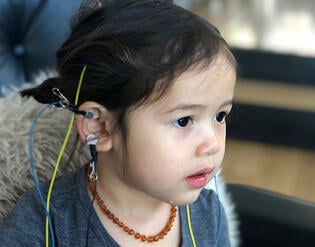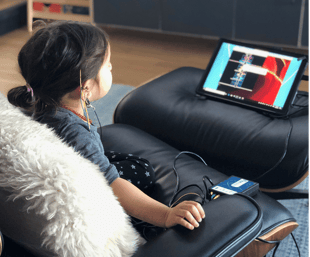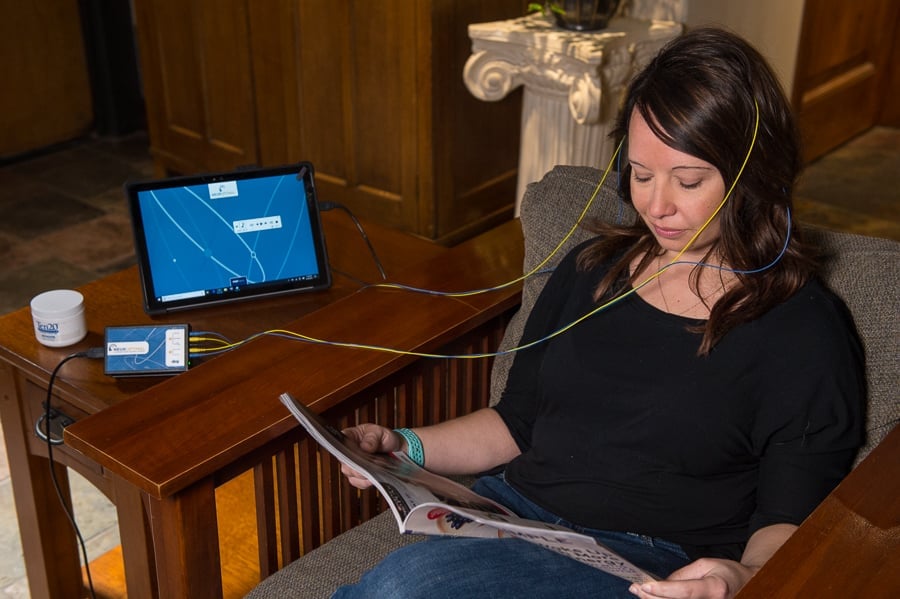Is Neurofeedback Safe? Which System is Best?
Is It Safe To Train Your Brain With Neurofeedback?
Yes, when using the NeurOptimal® neurofeedback system. Why? Because with this form of brain training, nothing is being "added" to your brain. The training happens purely through the system's delivery of precisely timed auditory feedback based on changes in your brain activity. Through these alerts, and the brain's natural ability to reset itself, users report many positive impacts on mood, mental functioning, sleep and performance.
 Unlike some devices that add a micro-current to the scalp, called microstimulation, with NeurOptimal® no electricity is directed to your brain. Brain activity is picked up by EEG sensors that are placed on the sides of the head and clipped to the ears.
Unlike some devices that add a micro-current to the scalp, called microstimulation, with NeurOptimal® no electricity is directed to your brain. Brain activity is picked up by EEG sensors that are placed on the sides of the head and clipped to the ears.
These sensors simply allow the system to recognize brainwave patterns; they do not send anything back to the scalp. During the training session, the user listens to a music soundtrack that provides auditory feedback the brain uses to reset itself millisecond by millisecond during each training session. Over a series of sessions, this process supports the brain's ability to optimize overall performance.
 Two Types of Neurofeedback Technology
Two Types of Neurofeedback Technology
There are different kinds of technology that are called neurofeedback or EEG biofeedback. With true neurofeedback, which includes systems like LENS®, NeurOptimal®, and BrainPaint®, there is no electricity being added to the brain.
They work by giving the brain the feedback it needs to re-wire circuits that underly unhealthy brainwave patterns.
Among this category of systems, the first type is linear or traditional neurofeedback, which uses clinician-set protocols to alert the brain to shift its activity away from patterns that are problematic towards activity that matches normal patterning.
This type of neurofeedback may have some side effects if not administered by an expert trainer who is certified in using the technology and has significant experience. With protocol-based neurofeedback it is not advised to see a trainer who is new to the field.
NeurOptimal is the second type, known as dynamical feedback. It is marketed as the most advanced iteration of brain training technology and is based on the natural non-linear processing patterns of the brain. Dynamical Neurofeedback™ has a unique design based on the brain's own ability to apply the principles of neuroplasticity to fix itself.
The power of this systems is its capacity to provide the brain with precisely timed feedback at the millisecond that brainwave patterns change. Because of this advanced design, the NeurOptimal® system is fully automated and does not require a diagnosis, or a trainer setting protocols during or in between sessions. It also does not require an expensive brain map before or during training.
ALSO READ
The History of Neurofeedback and How It Works on Wikipedia
Linear Neurofeedback Side Effects
When researching neurofeedback safety, a question to ask is whether there are side effects from neurofeedback. In general, side effects are uncommon. As mentioned above, with linear, or protocol based neurofeedback there can be some short-term side effects but they tend to be temporary, the result of pushing the brain too much towards one category of brainwave frequencies.
Following a session, a client may report feeling groggy, or like his or her mind is racing. Those sensations tend to dissipate on their own after a short period of time.
To understand in more detail why these side effects can happen, we have to discuss ordinary moment-to-moment changes in brain wave patterns and how they show up in our experience. Any activity, such as concentrating on a difficult task, trying to fall asleep, or being in a state of panic, has brainwave activity patterns associated with it. During linear neurofeedback, the brain waves are being measured and hopefully, changed.
For example, when we are doing a lot of mental work, such as problem solving, brainwaves known as Beta waves are more active. Sleep is associated with increased Theta brainwaves. If during a session, the trainer emphasizes Theta brainwaves, the trainee may get sleepy.
This effect is not long term (should subside within hours) and provides useful feedback for the trainer for the next session.
LEARN MORE
Brainwaves and How They Work
NeurOptimal® Side Effects
 With Dynamical Neurofeedback™ equipment it is hard to argue that any post-session experiences are side effects because nothing is being added to the brain nor is there any outside expert training the brain to increase or decrease any category of brainwave patterns.
With Dynamical Neurofeedback™ equipment it is hard to argue that any post-session experiences are side effects because nothing is being added to the brain nor is there any outside expert training the brain to increase or decrease any category of brainwave patterns.
An analogue for the feedback process is being seeing your reflection in a mirror. If you see your head is tilted you'll most likely automatically straighten it. NeurOptimal® alerts the brain that it is doing something and each brain will decide how to use the information it is presented with in order to optimize its own functioning.
The brain is actually designed to use its energy efficiently and effectively, but it doesn't always see that it is caught in a habitual pattern that is neither an efficient nor productive use of energy. The training is alerting the automatic functioning brain to pay attention to itself at the exact millisecond that the brainwave patterns are occurring.
The neurofeedback software registers data points from the brainwaves 265 times per second. It instantaneously registers changes, and uses sound technology to wake up the brain to what it is doing.
Clients report more awareness of physical sensations and emotions. A common post-session experience with people who are workaholics and don't sleep enough, is that they are tired. This is not a side effect. It is simply the result of becoming more aware of what is already there. Increased awareness allows us to attend to the areas of our life that need care, to help ourselves find balance.
For example if you are ignoring the need for rest, and you become aware of your tiredness, you are more likely to go to bed earlier. That's a win-win for you and your brain. Scientists recently discovered a subtle drainage system for metabolic waste that becomes active when we sleep; the brain essentially empties its garbage can at night!
This discovery aligns with the underlying view of the brain's self corrective capacity that the NeurOptimal system is based on.
In summary, with the NeurOptimal system there are no side effects because there are no active changes being made during training. The brain is simply being presented with feedback. The trainee's brain decides how to use that feedback based on current needs, and thereby to optimize itself.
How will I know if neurofeedback is working?
You may notice the effects of neurofeedback during your first session, shortly afterward or the next day. The occasional person may not notice a response to neurofeedback until two or three sessions have been completed. Factors that can influence how quickly you notice results include: the type of neurofeedback you are doing.
Other influencers may make it difficult to notice the changes. These could include a major life event, or an active illness that is producing bodily sensations you are focussing on.

Another factor is the age of the person doing brain training with neurofeedback. Children may or may not report changes after their first session or at all. In the case of children, parents and teachers are often the ones who notice changes. Parents may notice more cheerfulness, less impulsivity, getting along with siblings better, and fewer struggles around getting homework done. Children who suffer from performance anxiety may report feeling calmer from neurofeedback.
It is common for children to ask for neurofeedback when they're upset.

Typical changes that an adult brain training would notice after your first neurofeedback session would be feeling calmer, more grounded or relaxed, noticing greater mental clarity or less mental chatter, experiencing sense perceptions, such as sound as clearer.
For some after a few sessions they notice they are managing their sleep better, or feeling more rested when they wake up. Clients who are more aware of their body sensations tend to notice changes more quickly than those who are less aware.
This is also true for those more aware of their emotions. Often wives notice changes in their husbands' moods before the men notice.
With linear neurofeedback the number of sessions a client completes is determined by the standard protocol, whereas with Dynamical neurofeedback the client is more likely the determiner of the number of sessions because the equipment is safe and the design is based on optimization of brain performance as determined by each trainee's brain, not a clinicians protocols.
Once the client is noticing positive changes and tracking their goals, usually through self-reporting tools, they are confident in deciding when to stop neurofeedback.
How to decide which neurofeedback is right for you?
Here are some questions to help you decide on the right neurofeedback program for kids or yourself.
-
How important is safety to you?
If safety is your number one concern then I would recommend the NeurOptimal equipment because it is purely feedback. Information about the brain wave activity is collected and through micro-interruptions in music is the brain alerted to its activities. There is no external force pushing or pulling the client into a state change. Each brain will use the information it receives to improve its own functioning because that is how the brain is designed.
In 2018, the FDA ruled the NeurOptimal® system as a General Wellness device and not a medical device based on the safety of the system and its intended uses. This is good news for individuals wanting a program for brain wellness but that is safe and non-invasive. It is good news for parents looking to use neurofeedback for kids wellness, whether it's for school performance or social and performance anxiety.
-
Do you want to train in an office setting or use home neurofeedback?
 If you are looking at the linear protocol-based neurofeedback, then your only choice is neurofeedback therapy in a clinic or office setting.
If you are looking at the linear protocol-based neurofeedback, then your only choice is neurofeedback therapy in a clinic or office setting.
Clients will want to find a qualified clinician with many years of experience administering the neurofeedback therapy.
Why?
Because with protocol-based systems, the trainer is creating brain state changes by comparing your electrical brain wave patterns to "normal" brain patterns.
Linear neurofeedback is almost exclusively done in an office setting and their neurofeedback equipment is not designed for home use. BrainPaint does allow home use, but a certified trainer is providing the protocols to set at home.
 The only system designed for home as well as office use is the NeurOptimal® equipment. As explained above, it is fully automated and does not require protocols so the technology can be used safely by any adult. The automated feature gives you flexibility about where you train, whether it's in an office with a trainer, at home with a rental unit, or with a system you purchase.
The only system designed for home as well as office use is the NeurOptimal® equipment. As explained above, it is fully automated and does not require protocols so the technology can be used safely by any adult. The automated feature gives you flexibility about where you train, whether it's in an office with a trainer, at home with a rental unit, or with a system you purchase.
The key question to decide is whether you are someone who will set your own schedule and follow through at home.
Whether training in an office or home, using tracking tools is important to see the progress over time. It is common for clients to forget what they were experiencing when they started versus how they feel after completing the brain fitness program.
Like with any wellness regime, it's easy to forget what we were like in the beginning unless we have quantitative data points being taken at various points along the training. Like getting on the scale every week, with neurofeedback, you fill out a self-reporting checklist every ten sessions.
-
How important is the cost of neurofeedback sessions?
In general, linear neurofeedback costs more than Dynamical Neurofeedback™, because the session has to be administered by an expert trainer. This is usually only offered as in-office training, though some oversee setting protocols remotely with a home unit.
With Dynamical Neurofeedback™ there is the option of brain training in-person at a neurofeedback clinic, as a home rental or for purchase, all with the same technology and program. Regardless of the system, office neurofeedback sessions can range from $125-$300 per session, rentals range from $30 - $100 a session and if you purchase a system, the per session cost if spread out over years, can be as low as $10-$20/session.
LEARN MORE
 It's good to remember when pricing the cost of neurofeedback that any program requiring an expert to administer and oversee each session will significantly raise the cost per session and doesn't necessarily mean you are getting better brain training.
It's good to remember when pricing the cost of neurofeedback that any program requiring an expert to administer and oversee each session will significantly raise the cost per session and doesn't necessarily mean you are getting better brain training.
Depending on which system you choose, you may have flexibility and be able to self-administer the sessions. It is not uncommon for clients using Dynamical Neurofeedback™ to start with in-office sessions to get familiar with the process, begin noticing positive changes, and then after a handful of sessions switch to a home neurofeedback unit and dramatically lower their costs per session.
Whatever system you decide to use, neurofeedback is safe brain training, especially when under the guidance of an expert trainer.


